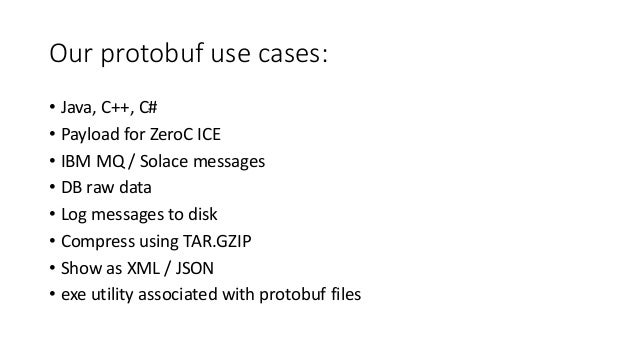
Java Serialization Vs Protocol Buffers Database
Oct 06, 2017 Protocol Buffer Basics: Java This tutorial provides a basic Java programmer's introduction to working with protocol buffers. By walking through creating a simple example application, it shows you how to Define message formats in a.proto file. Use Java Serialization. This is the default approach since it's built into the language. Java Protocol Buffers classes serialization. Is there something preventing Protocol Buffer Java classes from being. > >>> Protocol Buffer classes to store data.
At Criteo, Performance is everything. The serialization formats considered: • Protocol buffers • Thrift • Avro • Json • XML We did the benchmarking using a specialized library:, and C#.net 4.5. The data model Before digging into the implementation details, let us see the Data Model.
Our data is similar to an Excel workbook. It has got many pages, and each page is a table. In our case each table has got some keys indexing the rows. One difference with Excel though is that each cell may contain s more than just a single item. It could be a list of floating point values, a dictionary of floating point values, a dictionary of dictionaries, and so on. We represent data in a table like structure. Each column may have a different data type and every cell in a column has the same data type as shown in table below.

The cell’s value are implemented as subclasses of a base class called IData. We have one implementation of IData for each type of data structure we want to put in cells. Key Column1 Column2 Column3 Column4. String double Double[] Dictionary Dictionary String double Double[] Dictionary Dictionary String double Double[] Dictionary Dictionary String double Double[] Dictionary Dictionary Table 1 Example of the table like structure. In order to have fixed sample of data to serialize, We wrote a data generator that randomly generates the different possible values for each type of columns. The XML Story The original implementation was in XML so it became the reference benchmark for the other formats. Implementation was easy using the standard.net runtime serialization, simply decorate the classes with the correct attributes and voila.
Figure 1 DataContract annotations for serialization The interesting part is the “[DataContract]” and “[DataMember]” attributes which indicates to the serializer what members to serialize. The JSON Story Json is supposed to be faster and light-weight than XML. The serialization is handled by the Newtonsoft library, easily available in C#. There is just one small glitch here, in order to be able to correctly serialize and deserialize such dynamic data, we had to set the type name handling to automatic.
This resulted in json text with a type field. The Protocol Buffer story This has a lot of hype, which kind of makes sense because binary formats are most of the time faster than text formats, also the data model for the messages could be generated in many languages from the protobuf IDL file. The drill here is to create the IDL, generate C# objects, write convertors and serialize! But wait, which library should we use?
We found at least three different nugets, two of them claimed to implement the same version of Protobuf V3. Craigslist san francisco cars. • • • After much investigation, we realized that Google.Protobuf is provided by Google and had the best performance. Protobuf3 is compiled by an individual from the same source code but it is slower. There is more than one way to solve the problem with protobuf and we decided to try three different implementations and compare the performance. First implementation This implementation is referenced as protobuf-1 in our benchmarks. The design had to solve the problem of storing a polymorphic list. This had to be done using inheritance, and this explores different methods of implementing it.
We compared them and chose to use the type identification field approach as it had a better performance. Let’s see the example. Here, each cell of the table would contain one object of DataColumnMessage, which would have one field filled with values and the rest of them are null values. Protobuf does not store null values for optional fields, so the file size should not change a lot. But still this meant 4 null values and if the number of fields increase, that would mean even higher number of null values. Does that effect the performance? Keep reading for the comparison of results.
Second Implementation This implementation is referenced as protobuf-2 in our benchmarks. We knew that each column has the same data type, so we tried a column based design. Instead of creating one value for each cell, we decided to create one object per column. This object will store one field for the type of the objects stored, and a repeated value for each cell. Therefore drastically decreasing the number of null values and the number of field “type”.